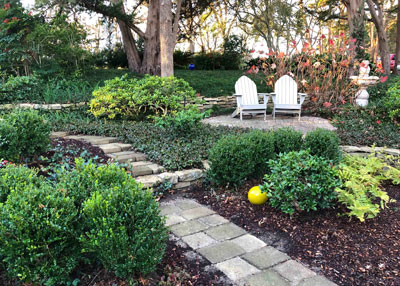Gardens to the South
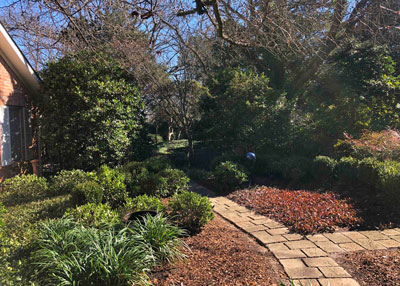
I try to develop “rooms” in my landscape. This serves as a glorified hallway from our courtyard around to our side yard and backyard deck. Click image for larger view.
Pretty much everything you see in this part of our travelogue used to be filled with thriving St. Augustine. However, as the trees grew larger their shade grew heavier. I finally decided to throw in the towel and switch over to more shade-tolerant plants.
I have pots of tropicals in this area in summer. You’ve seen them here in e-gardens before. This is where I use my small bromeliads – the trailing selections of Neoregelias. I have accumulated probably 100 different types, and I bring the best 30 or 40 out in the warm weather. They stay in pots that we sink halfway down into the ground. Right now they’re toasty warm in my greenhouse.
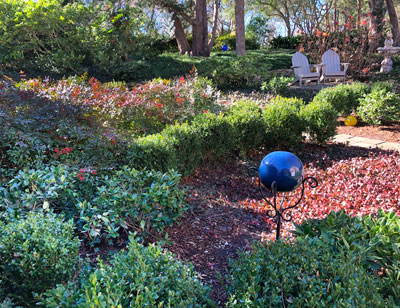
A 15-inch retaining wall breaks up a rather steep slope in this part of our landscape. Plants you see in this photo, from the bottom going upward: Wintergreen boxwood, Carissa holly, purple wintercreeper euonymus groundcover showing its reddish-purple winter color, Compacta nandina, and farther up on the hill, Dazzler holly, mondograss groundcover and the last remains of fall color on oakleaf hydrangeas. All of these plants have done well with a minimum of direct sunlight – too little to sustain St. Augustine in the same locations. Click image for larger view.
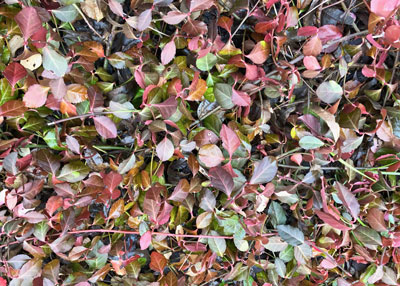
Purple wintercreeper euonymus is deep green all summer, turning reddish-maroon in the winter. It’s reliably winter-hardy in all parts of Texas, and it’s suited to sun or shade.
There are several things worthy of note in this photo. We made these concrete stepping stones 25 years ago. This is the third place where they’re been in our landscape. I made reusable forms and we poured 15 at a time. As the concrete began to set we pushed rock salt and a few leaves into the surface (rock salt into every one, leaves into a few). As they dried in a couple of days, we swept the rock salt off and gathered it to use again. It left pits in the concrete for an aged look. The leaves left their fossilized imprints. I used a rock hammer (with goggles!) to knock off all corners of each stone. And we repeated the process until we had enough stones for a walk.
Also, the Adirondack chairs are made out of recycled milk cartons. I bought them from a company called By the Yard (https://bytheyard.net) They’re very comfortable, and we’ve been very pleased with their durability.
Finally, I made this little patio myself from the leftover pavers when our driveway was finished. It’s no masterpiece, but it just goes to show you what you can do with scraps and determination.
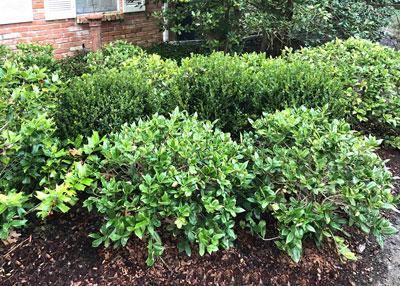
These Carissa hollies and Wintergreen boxwoods will be sheared very lightly in 4 or 5 weeks to create rounded plants, then they’ll be allowed to grow naturally the rest of the year.
I am a big fan of choosing plants that grow to the size that you want, then basically leaving them alone with minimal shaping and pruning. Such it is with the shrubs at our house. We do trim many of them one time per year, usually in late January or early February. We’ll use gasoline-powered hedge shears to sculpt dwarf hollies, boxwood and other rounded types into temporary globes. Those plants grow out with wonderfully full new shoots in the spring and I rarely touch them with shears again until the following winter. And we trim almost all of our nandinas (now planted in 10 or 12 different beds) to remove half of the canes (the tallest ones) to within 1 inch of the ground. That allows the nandinas to send up new shoots to keep the plants full.
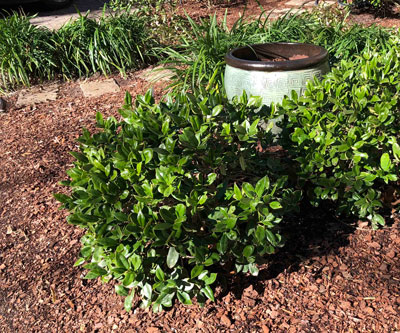
Carissa holly is a staple item in our landscape. It has completely taken the place of Indian hawthorns in my recommendations. Although it doesn’t bloom like the hawthorns, it is free of insects and diseases. Indian hawthorns have such problems now with the fatal Entomosporium fungal leaf spot.
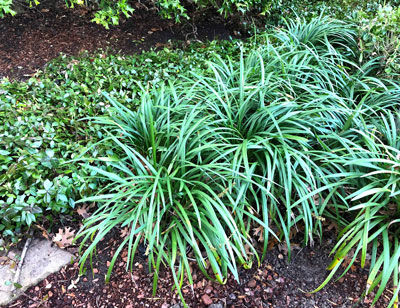
Giant liriope in the Sperry landscape. Photo taken in the past several days.
Sometimes you want a plant that bridges between being a groundcover and being a shrub. Giant liriope is just such a plant. It grows to 15 inches tall (taller when blooming in summer), and it brings a graceful elegance to its spot in the landscape.

